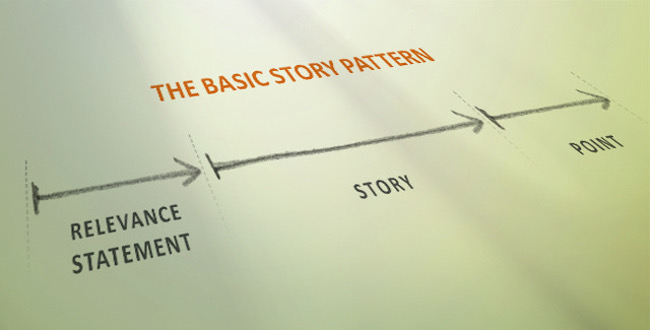Blog
Subscribe
Join over 5,000 people who receive the Anecdotally newsletter—and receive our free ebook Character Trumps Credentials.
Categories
- Anecdotes
- Business storytelling
- Collaboration
- Communication
- Corporate Storytelling
- Culture
- Decision-making
- Employee Engagement
- Events
- Fun
- Insight
- Leadership Posts
- News
- Podcast
- Selling
- Strategy
Archives
- April 2024
- March 2024
- December 2023
- November 2023
- October 2023
- September 2023
- August 2023
- July 2023
- June 2023
- May 2023
Years
Why would you share your point BEFORE telling your story?
Filed in Anecdotes, Business storytelling, Corporate Storytelling
Some practices in business storytelling are counterintuitive. Last week I gave a talk at the National Storytelling Network. The audience was mostly story experts, and one was a stand-up comedian. She was surprised to hear that I advocated sharing the point of your story before telling it. She said that in her comedy she wants her audience to be surprised by the actions in the story. The point just emerges from the telling. “In my experience,” I said, “Business people often get nervous if a colleague just launches into a story.” When a comedian is on stage, the audience trusts she will tell good stories that get everyone laughing. In contrast, there’s pressure to get to the point in business because leaders often frown upon anything that feels irrelevant.
You probably spotted it. The previous paragraph is an example of a point followed by a story. Granted, not the most exciting story ever told (however, quite typical of workplace stories). Yet, it illustrates the simple pattern of a point followed by a story, and this simple structure really helps business people tell their stories at work.
So, why does this story pattern help? I can think of four reasons.
Calm the nerves of your audience
First, it calms the nerves of the audience. When you hear someone making a definitive and relevant point, you think, “OK, that’s interesting. I might learn something here. I wonder if they have an example?” Of course, this line of thinking only happens if the opinion is relevant to the conversation. That’s why I call these types of opening sentences relevance statements. A relevance statement is usually a single sentence stating an opinion or learning that you will illustrate with an example (i.e., story). The teller calms nerves because the listener now knows the point of the story from the outset rather than being trapped by someone who just starts, “Last week I gave a talk at the National Storytelling Network…” And everyone wonders, “Where’s this going?”
Keep the story short
Second, a relevance statement keeps the story short and to the point. When the teller knows the point and tells everyone what that point is in the first sentence, they will stick to it, jettisoning any irrelevant bumf from the anecdote. There are no more blind alleys, no more Billy Connellyesque side trips, and no vague and off-base diversions. If your stories are rambling, this is the solution.
Make the story memorable
Third, starting with a point makes the whole story more memorable. As soon as you make your point in the first sentence, the listener keeps an ear out for when you prove it. Attention goes up. And because it’s a story, they might even be able to predict what will happen next. When that happens, comprehension spikes because they conjure the entire story in their mind’s eye and move in lockstep with your telling. Then, when you make the point, the penny drops, and a dopamine rush floods the nervous system, ensuring future recall.
Slip the story into conversation
Forth, prefacing your story with your point helps you slip the story into the conversation. I saw comedian Kevin Hart do this in a spirited discussion with four of his friends at a radio station. They were all talking over each other, and Kevin wanted to tell a story. So, he tried getting out his relevance statement, but everyone else’s chatter drowned it out. He tries again. Still no luck. Finally, they hear his third attempt, and now he has the floor. The relevance statement is a way to test if you have the attention and permission from the audience to tell your story. At that point, everyone stops to hear your anecdote.
Business storytelling is the mindful use of storytelling to make a business point, to engage, influence, and inspire. So knowing the point of your story is your first step. Know it. And tell your audience from the get-go why they should listen to you. Then when you tell your story, stick to your point and only have one. Not two. Just one. Finish your story by briefly restating your point. Don’t explain the whole story. No one wants that. Finish with a single sentence to wrap it up. Of course, that’s just one way to do it.
About Shawn Callahan
Shawn, author of Putting Stories to Work, is one of the world's leading business storytelling consultants. He helps executive teams find and tell the story of their strategy. When he is not working on strategy communication, Shawn is helping leaders find and tell business stories to engage, to influence and to inspire. Shawn works with Global 1000 companies including Shell, IBM, SAP, Bayer, Microsoft & Danone. Connect with Shawn on:
